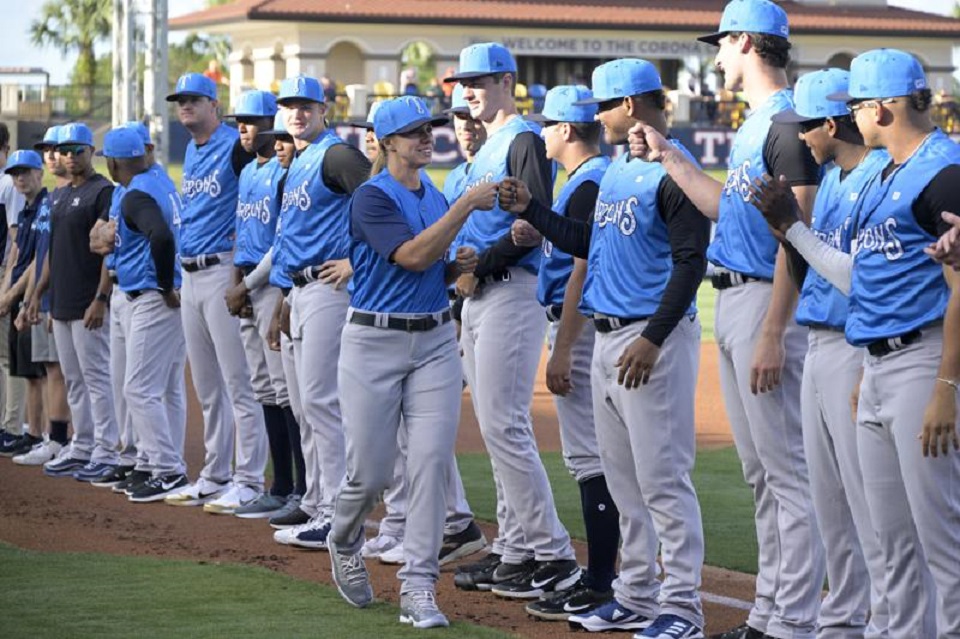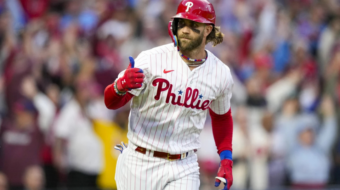
WASHINGTON—Starvation wages have struck out and poverty, at long last, has been shut out for baseball’s 5,500 minor league players, under their first-ever collective bargaining agreement, ratified at the end of March and taking effect immediately.
No wonder the players knocked ratification out of the park, passing it with 99% of the vote.
For more than a century, baseball’s “bush leagues” have been worse than the sport’s unknown embarrassment. They’ve been the error of exploitation, a capital E on baseball’s scorecard.
With few exceptions—primarily foreign stars and players already ticketed for stardom and almost instant promotion to the majors–the minor league story has been one of rampant and ruthless corporate greed by the major league owners, since the majors control the minors.
The result? Rattletrap bus rides from town to town, or crammed into airplane coach seats. Three or four or five guys living in a small apartment, some with wives and kids, too, because it’s all they could afford. Macaroni and cheese for dinner, or maybe McDonald’s. Paid for with food stamps.
Medicaid is your health care. Pay your own way, and your expenses, if you’re invited to major league spring training.
Players almost literally played for the peanuts fans could buy at ballpark concession stands. And you had a paying—if you could call it that—job for six months a year. Good luck the other six.
And if their team shut down, or if they got suddenly cut, it was “Get outta here, ya bum ya.” “Headed for the bigs? Fuhgeddabadit.”
No more. The sudden individual cuts may still occur, but now there has to be just cause for being fired. Most of the rest of the exploitation will be gone, too (Well, maybe not the bus rides.).
“The agreement represents a giant step forward in treating minor league players as the elite professional athletes they are,” said Major League Baseball Players Association Executive Director Tony Clark. MLBPA represents minor leaguers, too. They voted last September to unionize with it.
“It’s an historic day for these players, their families and the entire player fraternity,” said Clark, once a minor leaguer and then a major leaguer, mostly with the Detroit Tigers.
The minor leaguers’ pact, which runs from now through 2027, was one of two notable sports collective bargaining agreements reached at the end of March. The other tentative deal, signed by the National Basketball Players Association—the union—and the owners, is still subject to ratification.
Its money is richer, as are NBA players, but there are new limits on free agent movement.
Under the new minor leaguers’ CBA, rookie league players—the “starter job,” mostly for the youngest players—receive a four-bagger (a home run) rise in minimum base pay, from the current $4,800 to $19,800. Low Class A players, the next level up, hit a double. They’ll earn at least $26,200 and High Class A players will earn $27,300 or more. Both Class A groups now earn $11,000.
Minimums double, too, at the minors’ higher levels: From $13,800 to $27,300 at Double A (AA) level and from $17,500 to $35,800 at AAA, the highest minor league classification. And all minor leaguers will be paid all year, not just during the six-month league season. No more jobless lines.
Another key provision pays the minor leaguers for their spring training time in big league camps in Florida and Arizona. Until now, they got nothing and had to foot the bill for rent, cars, bringing their families if they could, and other expenses.
Under the new CBA, minor leaguers invited to big league camps get four weeks of pay each, at $625 weekly, and it’s retroactive to 2022 spring training, which just ended. They get $250 weekly when big league clubs order them to work out offseason at home. That figure was zero, too.
The new contract also guarantees job spots. Before the 2021 season started, the majors lopped off 20 of their 140-plus minor league clubs, in the name of economy, arbitrarily shutting out hundreds of players. The new pact bans any more such unilateral eliminations. It also sets older minor leaguers free of baseball’s infamous “reserve clause” more quickly.
Baseball’s current minor leaguers realized the value of unionizing after a group of former minor leaguers won an anti-trust suit against major league baseball owners last year in federal court in San Francisco. The past bush leaguers took home a settlement of more than $200 million combined.
The result was one of the world’s fastest union organizing drives, all of 17 days. It was so sudden and so successful that the minor leaguers and MLBPA hit the equivalent of a union grand slam: Card-check recognition. That was a complete turnaround from past owner hostility and attempts, including a recent lockout and prior owner salary collusion, to break the union.
The tentative seven-year basketball pact is more complex, according to Sports Illustrated and ESPN. That’s because it’s a major league pact covering some of the most well-paid stars in sports, led by LeBron James, now the NBA’s all-time career leader in scoring.
The deal still allots most league revenues to the players, and the revenue pot is larger, by at least $80 million for the players alone this coming season. That’s because it adds in $160 million in new revenues, from money sponsors pay to use the players’ name, image and likeness (NIL) to sell everything from basketball shoes to cereal to cars. Players and owners will split NIL dollars 50-50.
Like the current pact, the new one caps how much each team can spend overall on player pay. Teams can now breach the salary cap to re-sign their own stars, and the new pact enlarges such breaches. But it toughens the cap for any player who wants to switch teams as a free agent, as James and two fellow superstars once did, congregating in Miami to bring the Heat a flag.
That tougher cap change and others will be phased in over the first several years of the new contract to give teams in smaller markets more of a chance to sign top-tier talent.
We hope you appreciated this article. Before you go, please support great working-class and pro-people journalism by donating to People’s World.
We are not neutral. Our mission is to be a voice for truth, democracy, the environment, and socialism. We believe in people before profits. So, we take sides. Yours!
We are part of the pro-democracy media contesting the vast right-wing media propaganda ecosystem brainwashing tens of millions and putting democracy at risk.
Our journalism is free of corporate influence and paywalls because we are totally reader supported. At People’s World, we believe news and information should be free and accessible to all.
But we need your help. It takes money—a lot of it—to produce and cover unique stories you see in our pages. Only you, our readers and supporters, make this possible. If you enjoy reading People’s World and the stories we bring you, support our work by donating or becoming a monthly sustainer today.









